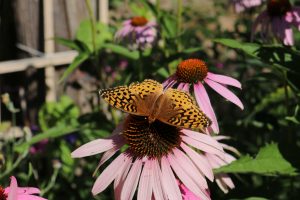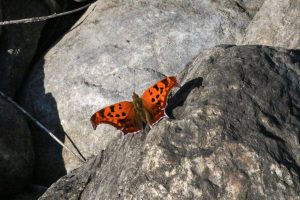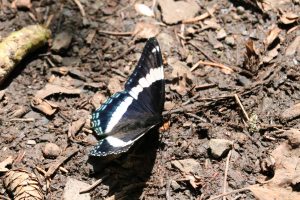by Monica Seidel, Digital Communications and Marketing Intern
Did you know that there are over 300 butterfly species in Canada, with 150 in Ontario alone? While most people are familiar with the iconic monarch and swallowtail butterflies, there are many other species fluttering around that would love to meet you.
Great spangled fritillary
 You may have seen this butterfly on a large native plant, like milkweed or spotted Joe-Pye weed. Great spangled fritillaries are found from British Columbia to Nova Scotia, living in marshes, damp meadows, clearings and sometimes along roadsides. They are very active and have wingspans up to 88 millimetres wide! Caterpillars crawl under leaves to hibernate soon after hatching over the fall and awake in the spring to feed on violets. Since fritillary species are very similar to each other, they must rely on pheromones and smell to find a mate of their own species.
You may have seen this butterfly on a large native plant, like milkweed or spotted Joe-Pye weed. Great spangled fritillaries are found from British Columbia to Nova Scotia, living in marshes, damp meadows, clearings and sometimes along roadsides. They are very active and have wingspans up to 88 millimetres wide! Caterpillars crawl under leaves to hibernate soon after hatching over the fall and awake in the spring to feed on violets. Since fritillary species are very similar to each other, they must rely on pheromones and smell to find a mate of their own species.
Question mark
 This is the largest butterfly in the angelwing family and has a wingspan of 45 to 68 millimetres. They are easily recognized by their distinctive wing shape, brown-orange colour and silver question mark shape found on their underside. They can be found in woodlands or urban areas, looking for animal droppings or sap from trees and rotting fruit to eat. This butterfly is thought to migrate to the U.S. for the winter and breed in Canada during the summer, though their migration is not well known.
This is the largest butterfly in the angelwing family and has a wingspan of 45 to 68 millimetres. They are easily recognized by their distinctive wing shape, brown-orange colour and silver question mark shape found on their underside. They can be found in woodlands or urban areas, looking for animal droppings or sap from trees and rotting fruit to eat. This butterfly is thought to migrate to the U.S. for the winter and breed in Canada during the summer, though their migration is not well known.
White admiral

Adult white admirals are usually seen in June and July in Canada in upland hardwood forests, clearings and barnyards, as they are attracted to the strong smell and moisture in poop! White admirals drink nectar from flowers and sap from rotting plants and have a wingspan of 50 to 80 millimetres. The caterpillars feed on willow, aspen and poplar, and other subspecies feed on birch, cherry and oak trees.
More than meets the eye
Butterflies are beautiful, but they also provide an incredible service to the planet. As pollinators, they move pollen from one plant to another, which allows the plant to become fertilized. Pollinators fertilize fruit-producing plants like blueberries, strawberries and pumpkins.
Threats
Butterflies’ critical food sources and habitat are impacted by heavy herbicide and pesticide use. Caterpillars often feed on one species of plant, which may be considered a “pest” or an unattractive species that people then mow or pull.
Another threat to butterflies, as with many wildlife species, is habitat loss and fragmentation. As human development replaces natural areas, butterflies are forced to ditches and roadsides where lack of appropriate habitat threatens the viability of caterpillars, and adults are often struck by oncoming traffic. Since butterflies migrate far distances, having suitable habitat across their entire range is not always easy.
How can I help?
You can help butterflies by providing water for them to drink from and bathe in. Natural areas with uncut grass, thistles and milkweed provide food and habitat. Leaf litter and tree debris on your property can provide a hibernation site for caterpillars. You can also plant a butterfly garden that features gorgeous native trees, shrubs and wildflowers.
Make sure to report your sightings to a database like eButterfly, Journey North or iNaturalist. By doing so, you will contribute to conservation research, meet other butterfly enthusiasts and grow your knowledge of local species.
___
This article was originally submitted as a guest blog contribution to the Nature Conservancy of Canada’s Landlines blog.
